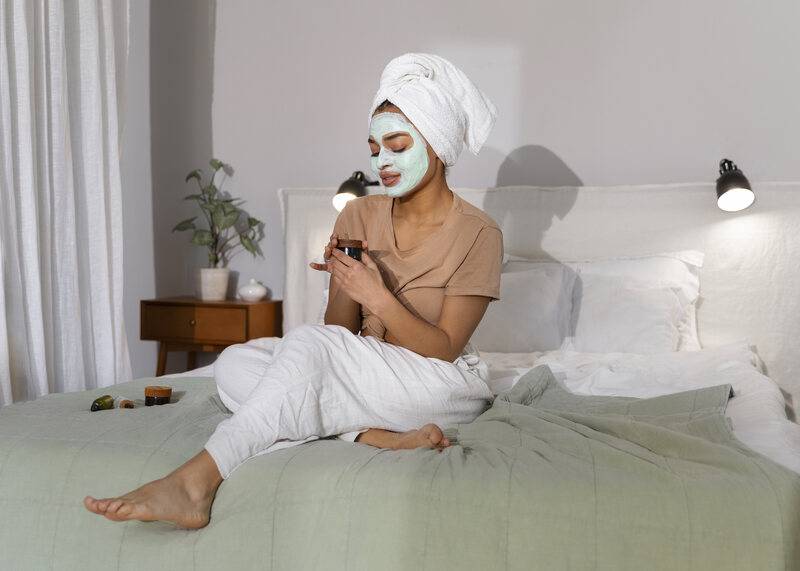Introduction
Skin Care Routine Morning and Night Steps: A consistent Skin Care Routine Morning and Night Steps is crucial for maintaining healthy, glowing skin. Whether you’re a skincare novice or a seasoned pro, knowing the right steps for both morning and night routines can make all the difference. In this guide, we’ll break down each step of a comprehensive skin care routine, providing tips and product recommendations to help you achieve your best skin ever.
Morning Skin Care Routine
Step 1: Cleansing

The first step in any morning routine is cleansing. Cleansing removes overnight sweat, oil, and any residual nighttime products, setting a clean base for the rest of your routine.Choosing the Right Cleanser: Opt for a gentle, hydrating cleanser if you have dry or sensitive skin. For oily or combination skin, a foaming or gel cleanser can help control excess oil without over-drying.Benefits of Morning Cleansing: Cleansing in the morning helps to refresh your skin, improve the absorption of subsequent products, and ensure that your face is free of impurities that could affect your makeup application.
Morning skincare routine begins by cleansing, a building block of radiant and healthy skin. Your body produces oil, sweat and dead skin cells during the night which can block pores if not washed off. The first thing you want to do when you wake up is get all of the impurities off your face that settled in it overnight. It likewise levels the common oils your skin generates to assist it not end up being as well completely dry or also oily throughout the day. Cleansing also helps to clear the pathway for serums, moisturizers and sunscreens allowing these products to penetrate deeper into your skin meaning that you will get far more from them. A light morning cleanse not only stimulates your skin but also protects it against external impurities, which will ensure that you maintain a clean and healthy complexion.
Step 2: Toning

Toning is an essential part of a skin care routine that helps restore the skin’s natural pH balance after cleansing, removes any leftover impurities, and tightens pores to improve skin texture. By preparing the skin to better absorb serums and moisturizers, toners enhance the overall effectiveness of your routine. Depending on their ingredients, toners can offer additional benefits such as hydration, soothing for sensitive skin, or astringency for oily and acne-prone skin. Applying toner with a cotton pad or your fingers and allowing it to absorb before moving on to other products ensures a clean, balanced, and more receptive skin surface, leading to a healthier and more radiant complexion.
Toning, though an important part of your am routine is often skipped. Toning — After you cleanse, toning restores your skin back to its proper pH balance that cleansers can disrupt. A toner a great way to eliminate any last remnants of impurities (dirt, oil and makeup) that your cleanser might have missed providing you with the cleanest skin possible.
It also closes your skin pores and thus makes them less pronounced, it helps unlock the absorbed product instead of resting on top like serums & moisturizers. Certain toners contain active ingredients like antioxidants, moisturizers or exfoliants that can target different skin concerns such as dryness and dullness, improving texture. A good toner will leave your skin feeling both toned and refreshed with a calibrated pH, as well as primed to absorb the full potential of the next steps in your skincare regimen.
Step 3: Moisturizing | Skin Care Routine Morning and Night Steps

Moisturizing is key to keeping your skin hydrated and protected throughout the day.
- Importance of Moisturizer: A good moisturizer helps to lock in hydration and create a barrier against environmental stressors.
- Recommended Moisturizers for Morning: Choose a lightweight, non-comedogenic moisturizer that won’t feel heavy under makeup. Gel-based or water-based moisturizers work well for oily skin, while cream-based options are better for dry skin.
Moisturizing every single morning under your sunscreen is also another must-do step in the skincare ingredients to use during the day. Your skin requires moisture after cleansing and toning, so it maintains softness suppleness and health all day long. Moisturizer a decent moisturiser can help the skin retain its water content, preventing drying and evaporation which messes with your skins acid mantle. It gives a barrier to protect your skin from pollution outside, severe weather condition and UV rays when you are using under the sunscreen. Moisturizers can be found in all sorts of formulations, ranging from lightweight gels to heavy creams, and are designed for various skin types and concerns. No matter whether your skin is oily, dry or combination moisturizing helps to balance the natural oils in our skin and while it may seem counterintuitive can help lessen breakouts and irritation.
Snscreen
- Sunscreen is arguably the most critical step in your morning routine.
- Why Sunscreen is Essential: Daily sunscreen use protects against harmful UV rays, preventing premature aging and skin cancer.
- How to Choose the Right Sunscreen: Select a broad-spectrum sunscreen with an SPF of at least 30. For sensitive skin, opt for mineral-based sunscreens with zinc oxide or titanium dioxide.
Optional Treatments
- Additional treatments can enhance your routine based on your skin’s needs.
- Vitamin C Serums: Vitamin C helps brighten the skin and combat free radicals.
- Eye Creams: Eye creams can reduce puffiness and dark circles, giving your eyes a refreshed look.
So in a morning skincare yo u can think of your optional treatments as like the injectionguard boosters that instead work on your skin issues however not individually and they are products to customize into what you need. These treatments can be serums, essences, ampoules, or spot treatments that target fine lines and wrinkles; hyperpigmentation; acne (pimples); congestion like blackheads or white bumps/rashes under the skin. A serum with Vitamin C will lighten your complexion and protect the skin from free radicals,, while HA essence hydrates soothes, softens enhances youthful bounce. Then, you can apply spot treatments that contain ingredients like salicylic acid to blemishes — this will help reduce redness and also (hopefully) speed up how quickly they heal. Including these alternatives ensures that your routine is bespoke and therefore ultimately more efficacious. Sometimes, these treatments are absolutely warranted — even if it is just to give yourself a leg up.
Night Skin Care Routine | Skin Care Routine Morning and Night Steps
Removing Makeup
- Properly removing makeup is essential to avoid clogged pores and breakouts.
- Best Makeup Removers: Use an oil-based makeup remover or micellar water to gently dissolve makeup and impurities.
- Importance of Makeup Removal: Ensuring all makeup is removed allows your skin to breathe and fully benefit from night-time treatments.
Step 2: Cleansing
- Cleansing at night is crucial for removing any remaining impurities and ensuring your skin is clean.
- Deep Cleansing for Night: A deeper cleanse can help remove impurities that accumulate throughout the day.
- Double Cleansing Technique: Consider double cleansing, first with an oil-based cleanser and then a water-based one to ensure all traces of makeup and dirt are removed.
Exfoliating | Skin Care Routine Morning and Night Steps
- Benefits of Exfoliation: Regular exfoliation can improve skin texture and radiance.
- Types of Exfoliants: Choose between physical exfoliants (scrubs) and chemical exfoliants (AHAs and BHAs). For sensitive skin, opt for gentle exfoliants to avoid irritation.
Exfoliating is a key step in any skincare routine, though it’s not typically a daily activity—especially in the morning. Exfoliation involves removing the layer of dead skin cells that can build up on the surface of your skin, leading to a dull complexion, clogged pores, and uneven texture. By gently exfoliating, you reveal the fresh, healthy skin underneath, which allows your skincare products to penetrate more effectively and boosts your skin’s natural glow. There are two main types of exfoliation: physical exfoliants, like scrubs with tiny grains, and chemical exfoliants, like alpha hydroxy acids (AHAs) or beta hydroxy acids (BHAs). Both have their benefits.
Toning
- Night-time toning helps to further refine your skin and prepare it for treatment products.
- Night Toning Benefits: Night-time toners can help restore moisture balance and remove any remaining traces of cleanser.
- Choosing Night Toners: Look for soothing ingredients like chamomile or aloe vera for a calming effect.
Treatment Products
- Treatment products target specific skin concerns.
- Retinoids and Their Benefits: Retinoids promote cell turnover and can help reduce the appearance of fine lines and wrinkles.
- Night Creams: Night creams are typically richer and more hydrating than day creams, providing deep nourishment while you sleep.
Moisturizing
- A good night cream or moisturizer helps to lock in hydration and support the skin’s repair processes.
- Rich Moisturizers for Night: Choose a thicker, richer moisturizer for night use to provide deeper hydration.
- Hydration vs. Moisturization: Hydration adds moisture to the skin, while moisturizing locks it in. Ensure you’re using a product that addresses both.
Tips for Maintaining a Healthy Skin Care Routine
- Consistency is Key
- Sticking to your routine is crucial for seeing results. Set reminders or integrate your routine into your daily habits to ensure you don’t skip steps.
- Establish a set time for your routine each day and keep your products in a visible location to remind you to use them.
Adjusting for Seasonal Changes
- Adapting Your Routine to Weather: In colder months, you might need richer moisturizers, while in warmer months, lighter, oil-free products might be more suitable.
- Avoiding Common Mistakes: Avoiding common pitfalls can help you get the most out of your routine. Mistakes to Avoid in Your Routine: Common mistakes include over-exfoliating, using products not suited for your skin type, and neglecting sunscreen.




